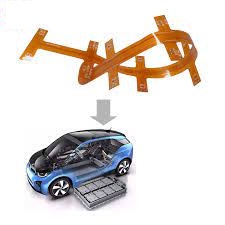In the fast-evolving world of electric vehicles (EVs), the demand for efficient, compact, and high-performing electronics is higher than ever. At the heart of these systems lies the printed circuit board (PCB), and when it comes to designing and manufacturing PCBs for EVs, Surface Mount Technology (SMT) plays a pivotal role. SMT PCB solutions enable high-density designs, miniaturization, and automated assembly, making them ideal for the complex needs of EV systems. In this blog, we'll explore how SMT is revolutionizing PCB design for electric vehicles, focusing on high-density PCB layouts, miniaturization PCB techniques, electronic components integration, and automated PCB assembly processes.
What is SMT and Why is it Essential for Electric Vehicle PCBs?
Surface Mount Technology (SMT) is a method of mounting electronic components directly onto the surface of a PCB, as opposed to older through-hole techniques where components are inserted into drilled holes. This technology has become a cornerstone in modern electronics due to its ability to support compact designs and high-speed automated assembly. For electric vehicles, where space, weight, and efficiency are critical, SMT offers unparalleled advantages.
In EVs, PCBs are used in various systems, including battery management systems (BMS), power inverters, motor controllers, and onboard chargers. These systems require high-density PCB designs to pack numerous components into limited space while maintaining reliability under harsh conditions like heat and vibration. SMT allows for smaller component sizes and tighter spacing, achieving the miniaturization PCB designs need to fit into compact EV modules.
The Role of High-Density PCB in Electric Vehicles
High-density PCB layouts are a direct result of SMT advancements. These boards are designed to accommodate a large number of electronic components in a small area, which is essential for EV applications. For instance, a battery management system in an EV might need to monitor hundreds of individual cells, requiring numerous sensors, microcontrollers, and communication circuits on a single board. SMT enables component placement with precision, often allowing for densities exceeding 100 components per square inch.
The benefits of high-density PCB designs go beyond just saving space. They also reduce signal path lengths, which can improve performance by minimizing electrical interference and signal delays. In an EV power inverter, for example, shorter signal paths can lead to faster switching speeds—often in the range of 10 to 20 kHz—resulting in more efficient power conversion. Additionally, high-density layouts help lower the overall weight of the vehicle, contributing to better energy efficiency.
Miniaturization PCB: Making EVs Lighter and Smarter
Miniaturization PCB techniques, enabled by SMT, are transforming how electronics are integrated into electric vehicles. Miniaturization involves shrinking the size of components and the overall PCB footprint without sacrificing functionality. This is crucial for EVs, where every gram of weight saved can extend the driving range.
SMT supports miniaturization by allowing the use of smaller components, such as 0201-sized resistors and capacitors, which measure just 0.6 mm by 0.3 mm. These tiny parts can be placed with extreme accuracy using automated machines, ensuring reliable connections despite their size. For instance, in an EV’s onboard charger, miniaturized PCBs can reduce the module’s size by up to 30%, freeing up space for other critical components or larger battery packs.
Beyond size reduction, miniaturization also enhances thermal management. Smaller boards with tightly packed components can be designed with advanced heat dissipation techniques, such as embedded copper layers or thermal vias, to handle temperatures that often exceed 85°C in EV environments. This ensures long-term reliability even under demanding conditions.

Electronic Components in SMT PCB for EVs
The choice of electronic components in SMT PCB designs for electric vehicles is critical to ensuring performance and durability. SMT allows for a wide range of components to be used, from passive elements like resistors and capacitors to active devices like microcontrollers, power transistors, and sensors. These components must meet stringent requirements for temperature tolerance, vibration resistance, and electrical performance.
In EV battery management systems, for example, SMT PCBs often include high-precision voltage and temperature sensors to monitor battery health. These sensors, typically surface-mounted, provide real-time data with accuracy levels within ±0.1% to prevent overcharging or overheating. Similarly, power electronics in motor controllers rely on surface-mounted MOSFETs and IGBTs capable of handling currents up to 500 A and voltages exceeding 600 V, ensuring efficient power delivery to the motor.
SMT also enables the integration of advanced communication chips, such as those supporting CAN bus or Ethernet protocols, which are essential for vehicle-to-everything (V2X) connectivity in modern EVs. These components, often packaged in small QFN or BGA formats, can be densely packed onto the PCB, supporting complex functionalities without increasing the board size.
Automated PCB Assembly: Speed and Precision for EV Production
One of the standout benefits of SMT is its compatibility with automated PCB assembly processes. In the high-volume production environment of electric vehicles, speed and precision are non-negotiable. Automated assembly lines use pick-and-place machines that can position over 100,000 components per hour with placement accuracy down to ±0.01 mm. This level of efficiency is vital for meeting the growing demand for EVs, which is projected to reach millions of units annually by 2030.
Automated PCB assembly also reduces human error, ensuring consistent quality across thousands of boards. During the SMT process, solder paste is applied to the PCB using a stencil, components are placed by robotic arms, and the board is heated in a reflow oven to create strong solder joints. Advanced inspection systems, such as Automated Optical Inspection (AOI), further enhance quality control by detecting defects like misaligned components or insufficient solder with a detection rate of over 99%.
For EV manufacturers, this means faster production cycles and lower costs. A single SMT assembly line can produce thousands of high-density PCB units daily, each ready to be integrated into critical systems like charging modules or driver assistance systems. This scalability is a key reason why SMT has become the preferred choice for EV electronics manufacturing.

Challenges and Solutions in SMT PCB Design for EVs
While SMT offers numerous advantages, it also comes with challenges that must be addressed to ensure reliability in electric vehicle applications. One major concern is thermal stress. EV systems often operate in extreme conditions, with temperatures ranging from -40°C to 105°C. High-density PCB designs can exacerbate heat buildup, potentially leading to component failure.
To counter this, designers incorporate thermal management solutions such as heat sinks, thermal pads, and multilayer PCB structures with dedicated ground planes for heat dissipation. Additionally, selecting components with high thermal ratings and using solder alloys with melting points above 200°C can enhance durability.
Another challenge is vibration resistance. EVs experience constant mechanical stress from road conditions, which can loosen SMT components or crack solder joints. To mitigate this, manufacturers use underfill materials to reinforce connections and design boards with vibration-dampening features. Testing standards, such as those set by the International Electrotechnical Commission (IEC), often require SMT PCBs to withstand vibrations up to 10 G without failure.
Future Trends in SMT PCB for Electric Vehicles
As electric vehicle technology advances, so does the role of SMT in PCB design and manufacturing. One emerging trend is the adoption of advanced packaging technologies like System-in-Package (SiP) and 3D stacking, which further enhance miniaturization PCB efforts. These methods allow multiple chips and components to be integrated into a single package, reducing the PCB footprint by up to 50% compared to traditional layouts.
Another trend is the increasing use of flexible and rigid-flex PCBs in EV designs. SMT is well-suited for assembling components onto these non-traditional substrates, enabling innovative designs that conform to irregular shapes within the vehicle. This is particularly useful in space-constrained areas like the dashboard or battery enclosure.
Lastly, the push for sustainability in EV production is influencing SMT processes. Lead-free soldering and eco-friendly materials are becoming standard to comply with regulations like the Restriction of Hazardous Substances (RoHS). Automated PCB assembly systems are also being optimized to reduce energy consumption, aligning with the green ethos of the EV industry.

Conclusion: SMT as the Backbone of EV Electronics
Surface Mount Technology has become an indispensable part of electric vehicle PCB design and manufacturing. From enabling high-density PCB layouts to supporting miniaturization PCB techniques, SMT allows for the creation of compact, efficient, and reliable electronics that power the next generation of EVs. The integration of advanced electronic components and the precision of automated PCB assembly further solidify SMT’s role in meeting the rigorous demands of the automotive industry.
At ALLPCB, we’re committed to providing cutting-edge SMT solutions tailored to the unique needs of electric vehicle applications. Whether it’s optimizing a high-density design or scaling production with automated assembly, our expertise ensures that your EV electronics perform at their best. As the industry continues to evolve, SMT will remain a key driver in making electric vehicles smarter, lighter, and more efficient.
 ALLPCB
ALLPCB







